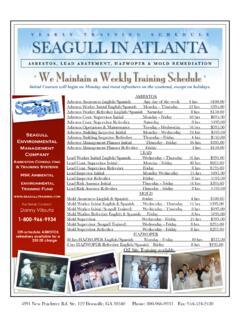Transcription of How Seagull Managers Make Everyone Miserable
1 ARTICLEBy Travis Bradberry, Unfortunately, we ve all been there. The boss finds his staff stumped by a problem and decides it s time to step in. But, instead of taking the time to get the facts straight and work alongside his team to realize a viable solution, he swoops in squawking, dumps orders riddled with formulaic advice, and then abruptly takes off, leaving them behind to clean up the Managers only interact with their employees when there s a fire to put out. Even then, they move in and out so hastily and put so little thought into their approach that they make bad situations worse by frustrating and alienating those who need them the Seagull manager is an increasingly common phenomenon hovering in today s workplace.
2 As companies flatten in response to the competitive changes created by new technology, industry regulation, and expanding global trade, they gut management layers. The remaining Managers are left with more autonomy, responsibility, and more people to manage. That means they have less time and less accountability for focusing on the primary purpose of their position managing people."While there s probably always been some Seagull Managers hovering inside the workplace, the recent flattening of organizations is breeding them like wildfire."It s easy to spot a Seagull manager when you re on the receiving end of their airborne dumps, but the manager doing the squawking is often unaware of the negative impact of this they aren t the only ones.
3 In the vast majority of organizations, senior leadership is unschooled in the profound, negative impact the Seagull Managers hovering about their organization are having on its bottom line. The very individuals with the authority to alter the course of an organization s culture lack the facts that would impel them to do are some hard truths we have to face every day at work: Employees whose manager often uses Seagull -type behaviors are 30% more likely to develop coronary heart disease than employees of a manager who rarely uses these behaviors. More than 2/3 of North Americans are actively considering leaving their current job, with their employers suffering annual losses in excess of $360 billion from this employee facts remind us that it s not easy being the one in charge: Just 21% of people would be willing to take their boss job.
4 When asked where they are supposed to focus, Managers overwhelmingly say, Bringing in the numbers yet they are most often fired for poor people the real question is not are you a Seagull manager, but when are you a Seagull manager? It would be wonderfully simple albeit frightening if we could each be categorized as the right or wrong kind of manager. It's just not that black and biggest fear in writing this post is that it will be used to target problem Managers , when the reality is we re all the problem. That s right. Every single one of us are Seagull Managers sometimes, in some situations, and with some people.
5 The real challenge lies in understanding where your Seagull tendencies get the better of you, so that you 2015 TalentSmart Associated logos are trademarks of TalentSmart, s Premier Provider of Emotional IntelligenceHow Seagull Managers Make Everyone MiserableARTICLEyou can fly higher and eradicate the negative influences of Seagull Adams experienced this first hand. After more than 20 years satirizing management culture through his wildly successful Dilbert comic strip, Adams agreed to roll up his sleeves and manage a restaurant he had co-owned for years from a safe distance. His foray into the rough-and-tumble world of management was a humbling one, and he was honest about his shortcomings in the real world.
6 "I m quite sure I ve succumbed in every so often and dumping on everything," Adams the title of Seagull manager isn t reserved solely for those who manage others in a formal capacity. Whether you re an engineer, a seasoned manager, or a novice climbing the corporate ladder, you must spot the situations where you engage in a Seagull style of management of the problems you face. The key to overcoming Seagull management is to tackle challenges when they are big enough to see, yet still small enough to solve. The Virtues of Superior ManagersThrough my involvement at TalentSmart I ve obtained a bird s eye view of the practices that are essential to a manager s job performance and the satisfaction of his or her staff.
7 We've found that superior Managers those who lead their teams to the greatest levels of performance and job satisfaction often share three critical habits, or virtues of superior Managers , are the polar opposites of the three distinguishing characteristics of a Seagull manager swooping, squawking, and Clear expectations. Managers who set clear expectations ensure that employee efforts are spent doing the right things the right way. This means thoroughly exploring what will be required of the employee, how their performance will be evaluated in the future, and getting agreement and commitment to work towards established goals.
8 There is a big difference between telling someone what s expected of them and making sure that what they ll be doing is completely Consistent communication. Consistent communication requires diligently observing what employees say and do, and speaking openly with them about their work. A manager s interaction with his or her employees delivers the resources, guidance, and recognition they need to succeed. Communication is effective when it is frequent and in a language that Everyone Powerful feedback. You can only provide powerful feedback when you pay careful attention to each employee s performance, while offering praise as frequently and emphatically as you do constructive feedback.
9 Powerful feedback pushes your team to new heights by positively reinforcing successful endeavors and realigning efforts that become the Seagull manager creates the need to swoop in and set his team straight, the superior manager gets Everyone headed in the right direction from the very beginning by ensuring that expectations are clear. Whereas the rare visit from the Seagull manager results in a lot of squawking, the superior manager maintains a steady flow of communication. And where the Seagull manager manages his team s performance by dumping on everybody, the superior manager keeps track of performance ensuring that positive and negative feedback are delivered in small, digestible It All TogetherIn the course of my work with organizations large and small, I ve witnessed a peculiar commonality among 2015 TalentSmart Associated logos are trademarks of TalentSmart, s Premier Provider of Emotional IntelligenceHow Seagull Managers Make Everyone MiserableARTICLEthe most successful enterprises.
10 These companies step confidently beyond the success strategies of conventional business wisdom brand strength, strategic leadership, technological innovation, customer service, and the like to leverage the single greatest resource inside every company its organizations recognize the degree to which Managers are the vessels of a company s culture, and even fewer work diligently, through training and coaching programs, to ensure their vessels hold the knowledge and skills that motivate employees to perform, feel satisfied, and love their may join companies, but they will leave bosses. No one influences an employee s morale and productivity more than his or her supervisor.


















